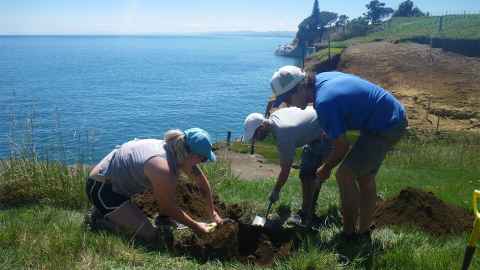It’s not just the size of the wave we need to worry about
22 July 2020
It’s widely thought that as sea levels rise due to climate change, coastal erosion will get worse but new research shows it’s not just wave height we need to be thinking about.

Coastal erosion is a recognised hazard in New Zealand with a number of coastal communities affected including at Taranaki, Auckland, and in the Bay of Plenty where shoreline cliffs have receded to such a degree that homes are threatened.
But award-winning research from the University of Auckland at a field site in Taranaki has found that it’s a particular type of wave that has the biggest impact on coastal cliffs, not necessarily the highest.
And one of the most interesting findings in the research was that it’s not necessarily storm waves that pose the biggest threat.
At the research site at Onaero Bay where cliffs are receding at a rate of several tens of centimetres per year, PhD graduate Catriona Thompson buried two seismometers at the top of the cliff to measure ground movement in response to the impact of individual waves.
She also set up two wave pressure sensors at the toe, or base, of the cliff to measure wave height and water depth, and placed a video camera on the shoreline to film each wave as it hit the cliff. In particular she recorded whether waves were broken, breaking or unbroken at the moment of impact.
She found that the impact of a wave which breaks against the cliff was significantly bigger than either broken or unbroken waves.
Measurements showed that the largest impact from a moderately-sized breaking wave was seven times greater than the biggest impact from the largest broken wave even during storms. Unbroken waves have even less impact on cliff ground shaking, the largest unbroken wave impact being about 19 times smaller than that of the largest breaking wave.
“Breaking waves generally caused more ground motion regardless of wave height when compared to broken or unbroken waves,” Dr Thompson says. “From this field work it’s evident that waves that break against the cliff are having the biggest impact.”
“We think that’s going to be significant in terms of even modest sea level rise because water depth near the base of the cliff determines what kind of waves the cliff face is exposed to.”
Associate Professor Mark Dickson, who was also involved in the research, says that they were very interested to discover that storm waves, which are usually associated with cliff erosion, didn’t result in the greatest ground shaking.
This was because storm waves break in deeper water and dissipate a lot of their energy prior to impact.
“This work is quite significant in the way we look at coastal erosion, particularly in the context of global sea level rise, and the way that wave energy will be delivered to coastal cliffs in the future,” he says.
The study is the first to look at coastal erosion by measuring ground motion at the seismic level while also recording the impact of individual waves. It shows that sea level rise is likely to have two different effects: in areas where there is a significant rise in sea level, sea height could increase the number of breaking waves while in other areas it might mean a higher number of unbroken waves, which could actually decrease erosion rates.
“Rather than just looking at the tide cycle or storm events, this is the first time we’ve recorded different types of wave motion and we think it really does provide better understanding of how sea level rise will affect New Zealand’s coastal cliffs,” Dr Thompson says.
The study has been recognised by the British Society for Geomorphology which has awarded it the Michael Kirkby Award (previously known as the Wiley Award) for best paper published at Earth Surface Processes and Landforms in 2019.
As part of the Award Dr Thompson will present the findings at a meeting of the Society in September although this year the event is being held online.
Media contact
Anne Beston | Media adviser
DDI 09 923 3258
Mob 021 970 089
Email a.beston@auckland.ac.nz